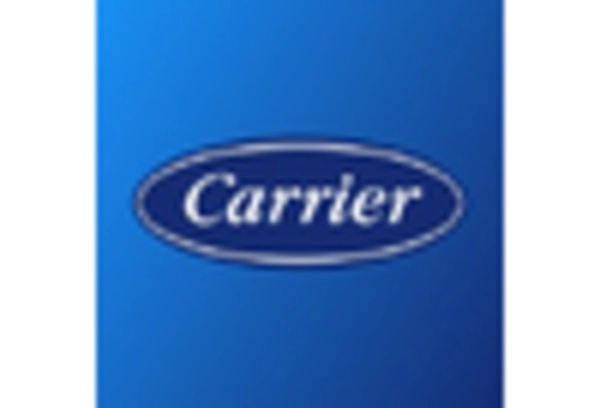Increased Demand for Energy Efficiency
The Data Center Refrigerant Market is experiencing heightened demand for energy-efficient cooling solutions. As data centers expand, the need for effective thermal management becomes paramount. Energy-efficient refrigerants not only reduce operational costs but also align with sustainability goals. According to recent studies, energy-efficient systems can lower energy consumption by up to 30%, which is crucial for data centers that operate 24/7. This trend is likely to drive innovation in refrigerant technologies, as companies seek to optimize their cooling systems while minimizing environmental impact. The push for energy efficiency is further supported by corporate sustainability initiatives, which emphasize the importance of reducing carbon footprints. Consequently, the Data Center Refrigerant Market is poised for growth as stakeholders prioritize energy-efficient solutions.
Emergence of Advanced Cooling Technologies
The Data Center Refrigerant Market is witnessing the emergence of advanced cooling technologies that enhance operational efficiency. Innovations such as liquid cooling and immersion cooling are gaining traction, offering alternatives to traditional air conditioning systems. These technologies can significantly improve heat dissipation, thereby optimizing the performance of data centers. For instance, liquid cooling systems can achieve cooling efficiencies of up to 50% compared to conventional methods. As data centers increasingly adopt these advanced cooling solutions, the demand for specialized refrigerants tailored to these technologies is likely to rise. This shift not only addresses the challenges of heat management but also aligns with the industry's broader goals of sustainability and energy efficiency. The integration of advanced cooling technologies is expected to reshape the landscape of the Data Center Refrigerant Market.
Regulatory Pressures for Low-GWP Refrigerants
The Data Center Refrigerant Market is under increasing regulatory pressures to transition to low-global warming potential (GWP) refrigerants. Governments and environmental agencies are implementing stringent regulations aimed at phasing out high-GWP refrigerants due to their detrimental effects on climate change. This regulatory landscape is compelling data center operators to seek alternatives that comply with these new standards. The market for low-GWP refrigerants is projected to grow significantly, as companies strive to meet compliance requirements while maintaining operational efficiency. The shift towards low-GWP options not only mitigates environmental impact but also enhances corporate reputations. As a result, the Data Center Refrigerant Market is likely to see a surge in demand for innovative refrigerant solutions that align with regulatory frameworks.
Rising Data Center Construction and Expansion
The Data Center Refrigerant Market is benefiting from the rising construction and expansion of data centers worldwide. As digital transformation accelerates, organizations are investing heavily in data infrastructure to support increased data processing and storage needs. This expansion necessitates efficient cooling solutions, driving demand for refrigerants that can effectively manage heat in larger facilities. Market analysts project that the data center construction sector will grow at a compound annual growth rate of over 10% in the coming years. This growth trajectory indicates a robust demand for refrigerants that can cater to the unique cooling requirements of modern data centers. Consequently, the Data Center Refrigerant Market is positioned to capitalize on this trend, as new facilities require advanced refrigerant solutions to ensure optimal performance.
Focus on Sustainability and Environmental Responsibility
The Data Center Refrigerant Market is increasingly focused on sustainability and environmental responsibility. As stakeholders become more aware of the environmental impact of refrigerants, there is a growing emphasis on adopting eco-friendly alternatives. Companies are actively seeking refrigerants that not only comply with regulations but also contribute to their sustainability goals. This trend is reflected in the rising popularity of natural refrigerants, such as ammonia and carbon dioxide, which have lower environmental impacts compared to traditional options. The market for sustainable refrigerants is expected to expand as organizations prioritize environmentally responsible practices. This focus on sustainability is likely to drive innovation within the Data Center Refrigerant Market, as manufacturers develop new products that align with the principles of environmental stewardship.

















Leave a Comment